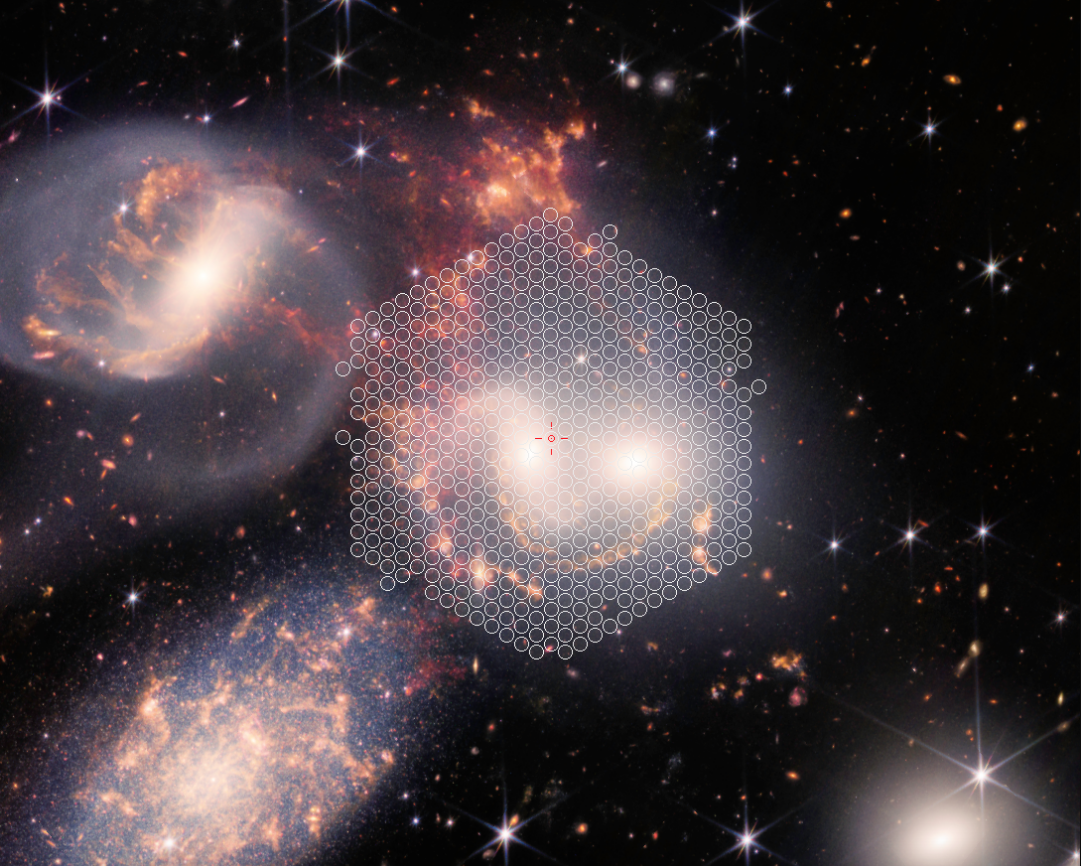First light of the WEAVE instrument in which INAOE participates
The Isaac Newton Group of Telescopes (ING) and the WEAVE instrument team presented first-light observations with the WEAVE spectrograph. The WEAVE team looked at the heart of Stephan's Quintet, a group of interacting galaxies famous, among other reasons, for their film role in the 1946 Christmas movie "It's a Wonderful Life." They imaged NGC 7318a and NGC 7318b, a pair of galaxies at the center of a large colliding galaxy at a distance of 280 million light-years, in the constellation Pegasus.
WEAVE is an instrument that breaks down light into its different colors. It has several modes of operation, all of them based on fiber optics. Recently, it was installed in the William Herschel Telescope (WHT), located at the Roque de los Muchachos Observatory, in La Palma, Canary Islands. It was built by a consortium of European astronomical institutions, led by the UK Science and Technology Facilities Council, to become the next-generation spectroscopic facility for the WHT. INAOE is the only institution outside of Europe invited to participate in this project, thanks to its reputation for the development of astronomical instrumentation, as well as for the quality of astrophysics research carried out in Tonantzintla.
WEAVE's versatility is one of its greatest strengths. The Integral Field Spectroscopy mode houses 547 fibers packed in a dense hexagonal pattern and is used to study extended objects such as nebulae and nearby galaxies. In multi-object spectroscopy mode, up to 960 individual fibers can be separately positioned using two robots to collect light from hundreds of stars or galaxies. In the integral field multi-spectroscopy mode the fibers are arranged in 20 units, each consisting of 37 fibers, which will be used to study small extended targets such as nebulae and distant galaxies. In all modes, the fibers transfer light to the same WEAVE spectrograph for analysis and recording.
The spectrograph separates the light into its different wavelengths, or colors, and records them on large-format CCD-type light detectors. This is how spectra are built and transferred via the Internet to computers in Cambridge and Tenerife. After processing, the data is stored in a file on La Palma for scientific use. The spectra thus obtained contain the imprint of the physical and chemical properties of stars, galaxies, and interstellar and intergalactic gas that astronomers use to compare their theories about the Universe.

The image shows the field integral unit targeting Stephan's Quintet during first light observation. The light is collected by 547 optical fibers for analysis by the WEAVE spectrograph. Each circle indicates an optical fiber 2.6 arcseconds in diameter. The observation provides physical information about the different regions of each galaxy, as well as the space between them. Credits: NASA, ESA, CSA, STScI (background image); Aladin (fiber coating).
The first-light observations were carried out using the integral field unit that allows obtaining spectra of 547 different regions of the two galaxies, recording light from ultraviolet to near-infrared. The spectra reveal the motions of stars and gas, the chemical composition of stars, the temperatures and densities of gas clouds, along with much more information. From these data, astronomers can learn how galaxy collisions transform galaxies into groups.
Marc Balcells, Director of ING, explains: "Our goal was to host a unique instrument that would enable cutting-edge astronomical research to be carried out. It has been fantastic to receive extensive financial support from the national research agencies in the three partner countries, as well as contributions from non-ING countries Now we are pleased to demonstrate that WEAVE produces very high quality data.”
Gavin Dalton, WEAVE Principal Investigator, said: "The richness and complexity of the information revealed by just observing this pair of nearby galaxies will contribute to the interpretation of the many millions of spectra that WEAVE will obtain of galaxies in the distant Universe and provide an excellent illustration of the power and flexibility of WEAVE.”
Scott Trager, Project Scientist commented: "These observations show the power of WEAVE to unravel the complex phenomena involved in the evolution of galaxies throughout the history of the Universe. The more than 500 members of the WEAVE science team and members members of the broader ING community will undoubtedly make great discoveries with WEAVE's extraordinary new capabilities."
In 2016, the UK, Spain and the Netherlands, the ING association countries, along with France and Italy, signed an agreement to design and build WEAVE. Each country contributed the main components and the ING provided ancillary and general project management systems. WEAVE's spectrograph is one of the nine main components of the instrument. INAOE contributed to the optics of the spectrograph, as a whole by The Netherlands Research School for Astronomy, The Netherlands, according to the design submitted by Rutherford Appleton Laboratory, United Kingdom.
Esperanza Carrasco, Principal Investigator of WEAVE-Mexico, highlights that “INAOE is one of the institutions external to the ING that has contributed to the construction of WEAVE. In the INAOE optics workshop, under the direction of Rafael Izazaga, seven large format lenses were manufactured for the blue arm camera and seven for the red arm camera, as well as the collimating mirror for the spectrograph. Thanks to this contribution, which had the support of CONACYT, the WEAVE scientific group within INAOE will have guaranteed observation time”. He also highlighted that "Participation in the development of large scientific infrastructures such as WEAVE offers, on the one hand, the opportunity to demonstrate and improve the technical skills of INAOE and, on the other, access to frontier instrumentation that would not be available otherwise. way".
The press release issued by the Isaac Newton Group of Telescopes is available at the link:
https://www.ing.iac.es/PR/press/weave_LIFU_first_light.html
The research article that describes the eight surveys that will be carried out by the WEAVE scientific group has already been accepted for publication and can be read at the link: http://arxiv.org/abs/2212.03981
Luis Enrique Erro # 1, Tonantzintla, Puebla, México, Código Postal 72840, Tel: (222) 266.31.00, difusion@inaoep.mx
This work is licensed under a Creative Commons Attribution-NonCommercial-NoDerivs 2.5 Mexico License.


